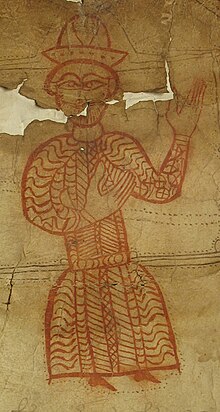| George VII გიორგი VII | |
|---|---|
 | |
| King of Georgia | |
| Reign | 1393–1407 |
| Predecessor | Bagrat V |
| Successor | Constantine I |
| Born | 1360s |
| Died | 1407 |
| Burial | |
| Spouse | Nestan-Darejan |
| Dynasty | Bagrationi dynasty |
| Father | Bagrat V of Georgia |
| Mother | Helena Megale Komnene |
| Religion | Georgian Orthodox Church |
| Khelrtva |  |
George VII (Georgian: გიორგი VII, romanized: giorgi VII) (died 1405 or 1407) was king (mepe) of Georgia from 1393 to 1407 (alternatively, from 1395 to 1405).[1] Bagrat V's son and successor, George put up a stiff resistance and had to spend much of his reign fighting Timur and his Empire.
During his father's lifetime, he ruled over different parts of Georgia, and he is referred to as a king in the sources from that time. During the reign of George VII in 1394-1403, Timur invaded Georgia many times. During Timur's invasions on Georgia, his army brutally destroyed Hereti, Kakheti, Trialeti, Kvemo and Shida Kartli, Imereti. The main goal of Tamerlane was to conquer and convert the country to Islam. Despite the great cruelty, he was still unable to overcome the resistance of the Georgian people and capture King George.
George was the son of the king Bagrat V and his first wife Elene of Trebizond (died of bubonic plague, 1366).[2] Bagrat appointed him co-ruler in 1369.
When the Tbilis fell on 22 November 1386, its inhabitants were massacred and Bagrat fell into captivity. Timur's army spent the winter in Karabakh. To regain his freedom, Bagrat pretended to convert to Islam and Timur sent him back under surveillance of a 12,000 strong army which was to enforce Georgian Kingdom conversion to islam. Bagrat secretly informed his son George, who raised an army and destroyed the Timurid troops, and freeing Bagrat.[3]
In 1393, Bagrat died and George assumed full royal powers. He spent most of his reign fighting Timur who led seven more expeditions against the stubborn Georgian kingdom from 1387 to 1403, leaving the country in ruins.
While Tamerlane was campaigned in India in 1399, The Georgians took advantage, George VII and Sayyid Ali of Shaki attacked Azerbaijan and besieged the Alinja fortress and rescued the daughter of Ahmad Jalayir the ruler of Jalayirid Sultanate. Miran Shah sent general Seif ad-Din, The Georgians defeated the new army sent by Miran Shah but Sayyid Ali died in that battle. Georgian king refused to return the hostages with explanation that this would be against of the Caucasian traditions and Tamerlane personally started preparation for invasion against Georgia.[4]
Finally, in 1403 George had to make peace with the fierce enemy, recognising Timur as a suzerain and paying him tribute, but retaining the right to be crowned as a Christian monarch
In the aftermath of Timur's death in February 1405 and the subsequent power struggles among his heirs, Timur's empire became fragmented as Miran Shah and his sons struggled over control of Persia. In the midst of this chaos, George, who had returned from Imereti, engaged in battles to regain lost territories. He managed to conquer Nakhchivan and Ganja while also causing destruction in places like Ani, Erzurum, and Tabriz. Despite commanding an army of merely 5,000 men, George succeeded in expanding Georgia's borders temporarily to their former extent.[5]
According to Vakhushti, He was killed in battle against the Turkmen nomads, apparently of the Kara Koyunlu clan. Today, some historians consider this information of Vakhushti doubtful and claim that George VII died of natural causes.[6]
George VII may have died childless, as his brother Constantine I became the next king.